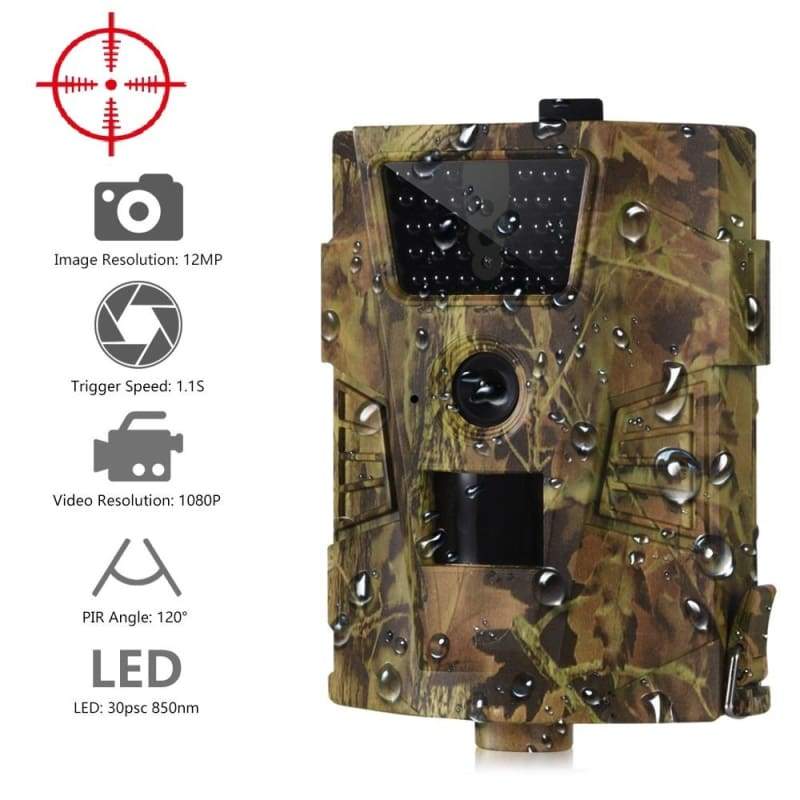

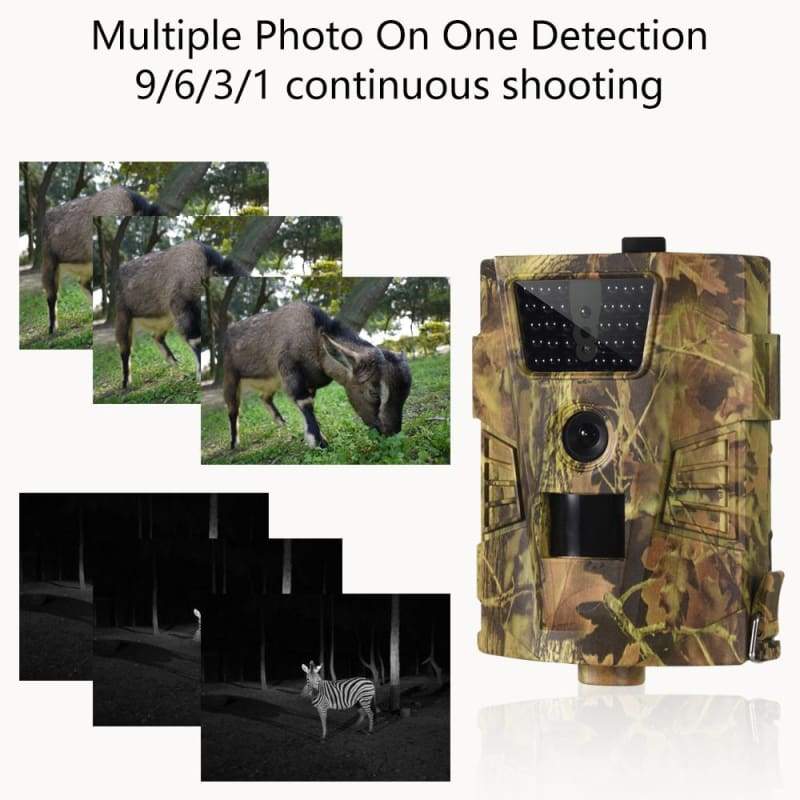


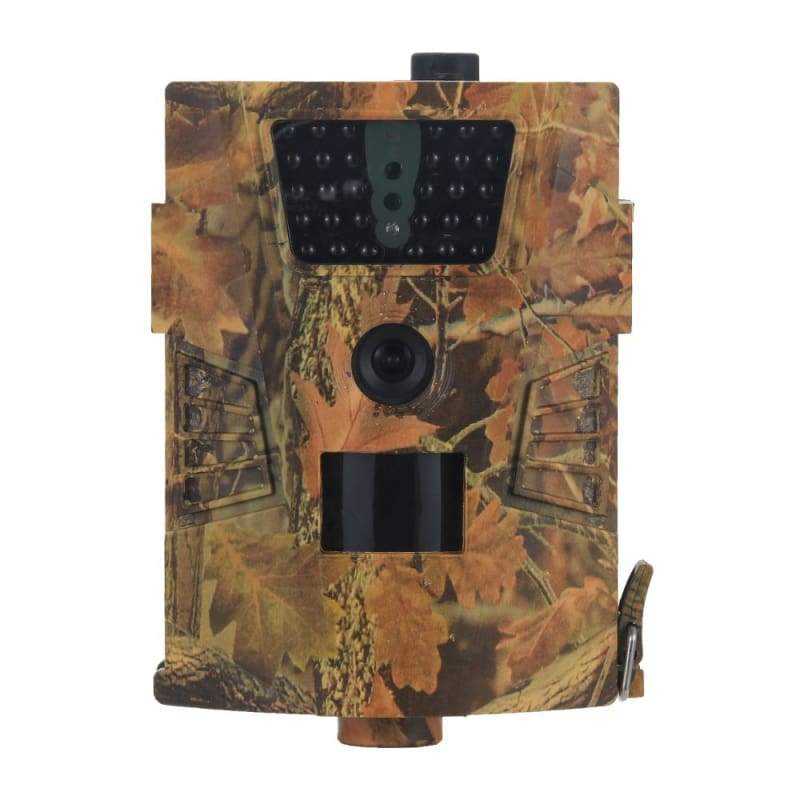
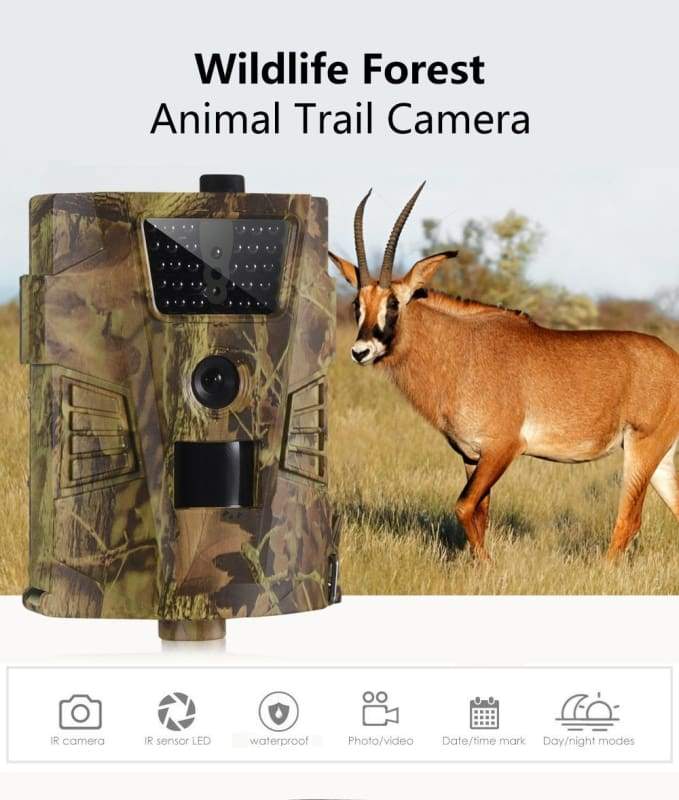
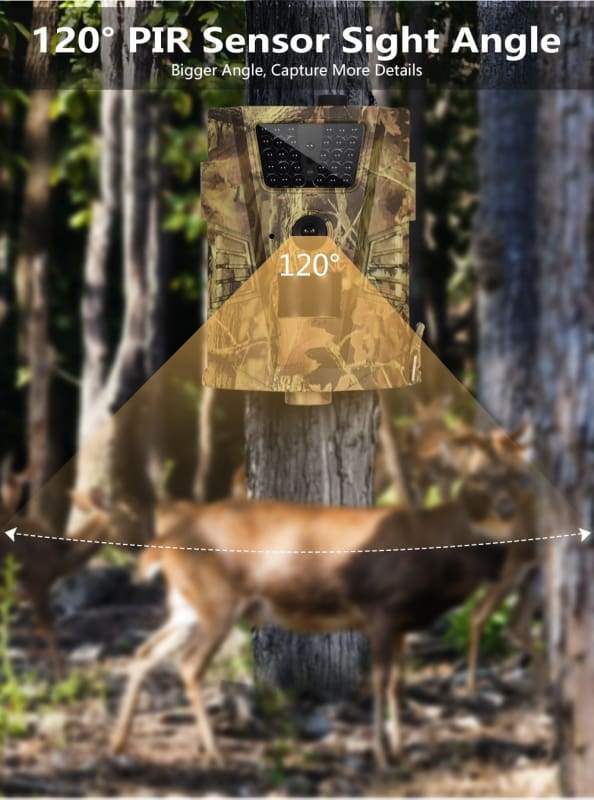
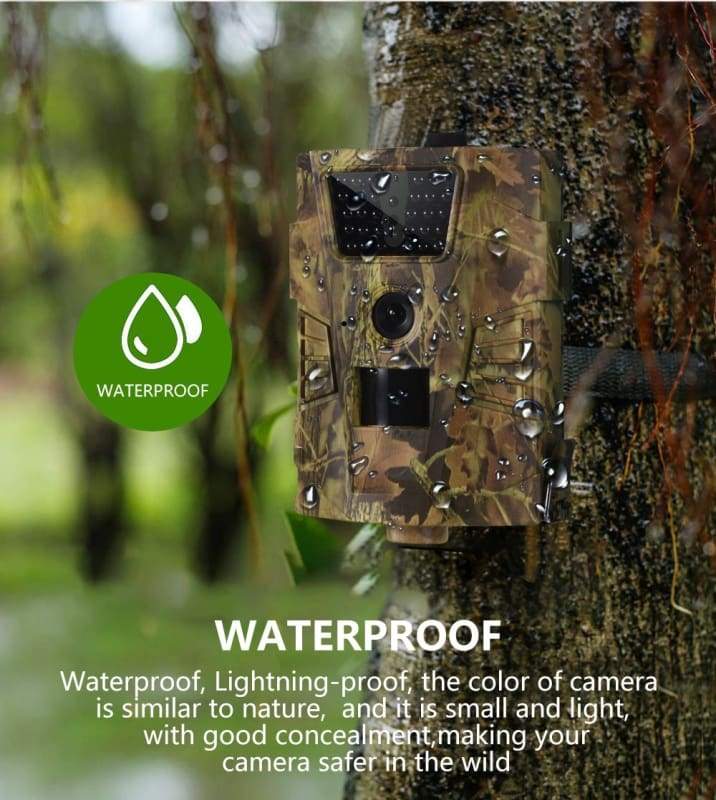
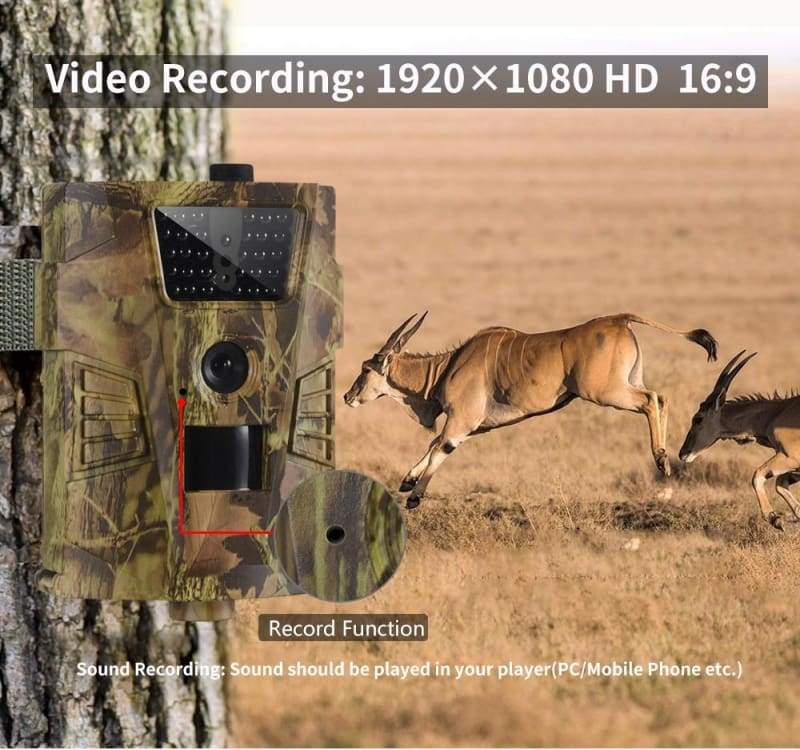
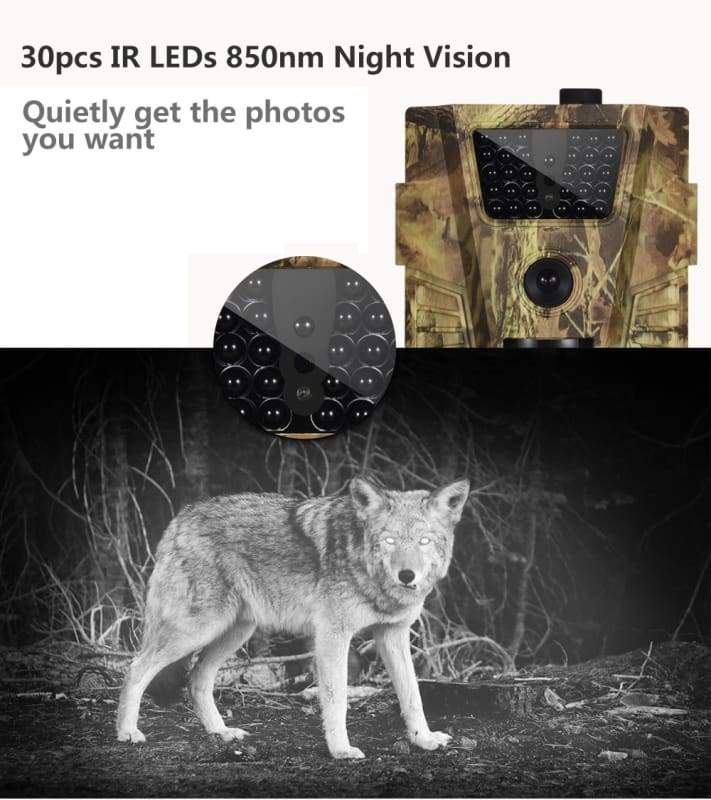
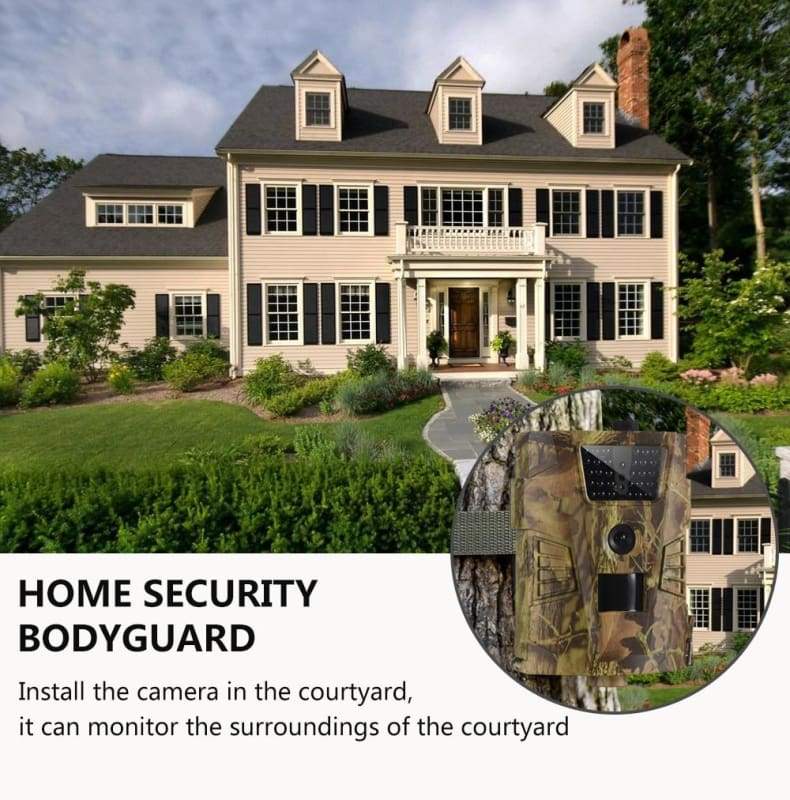
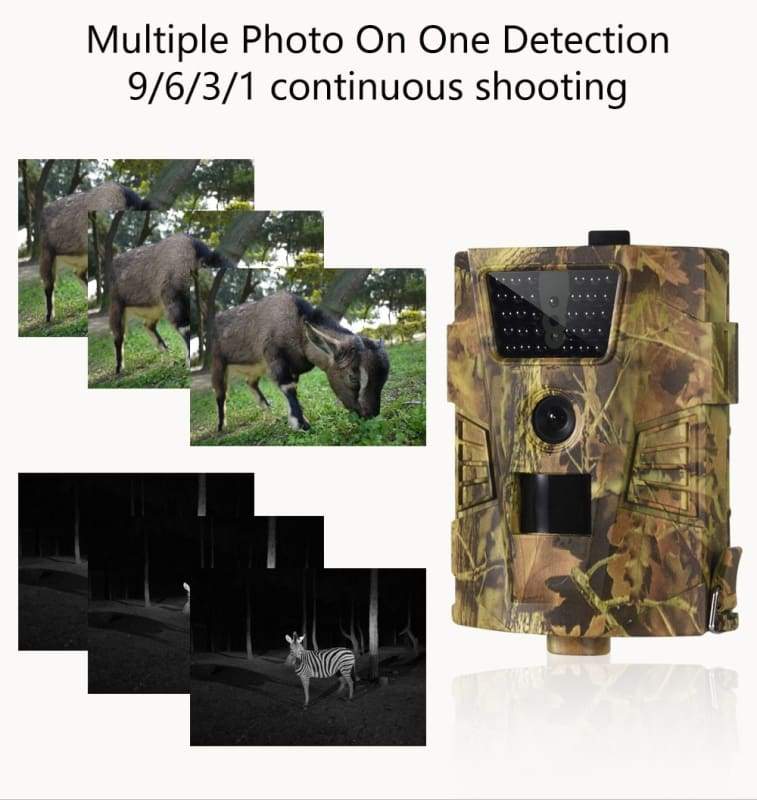
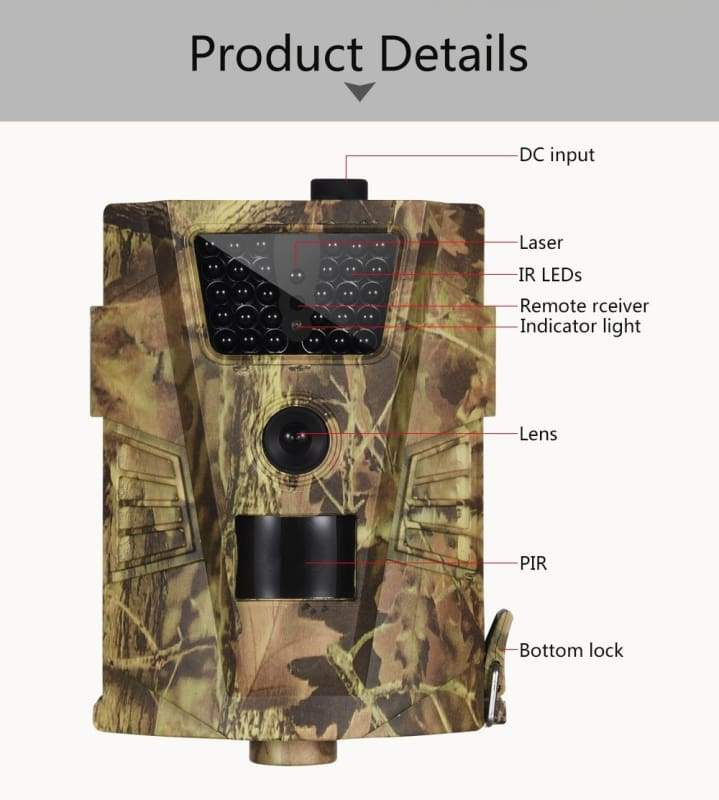
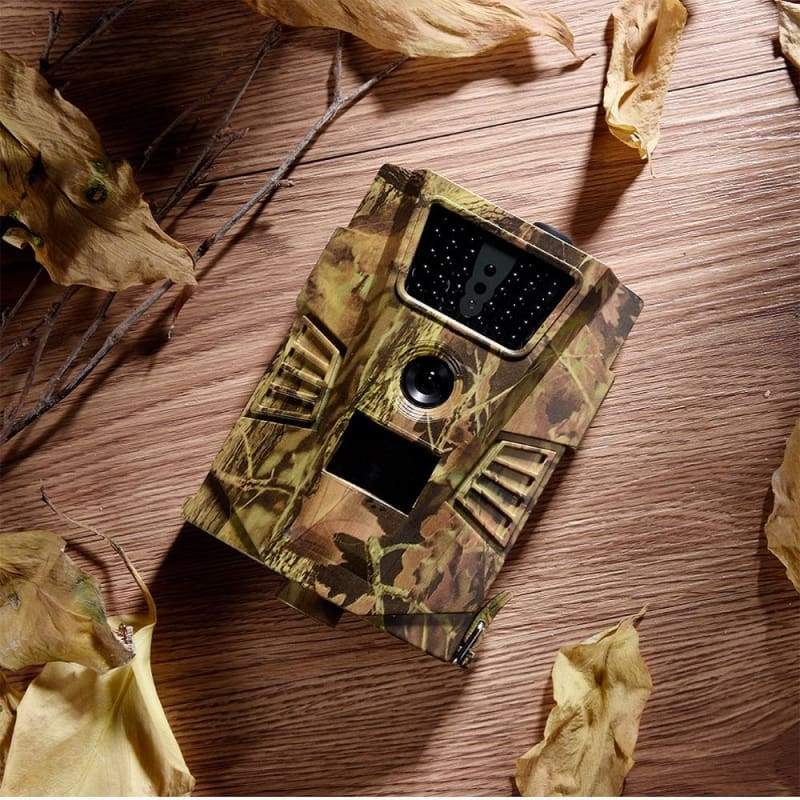
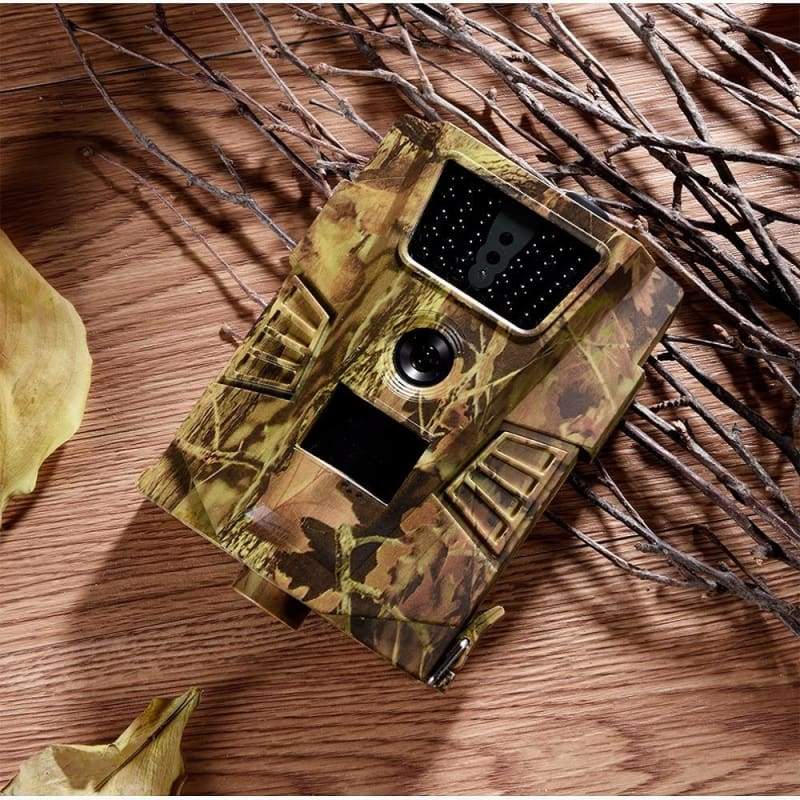
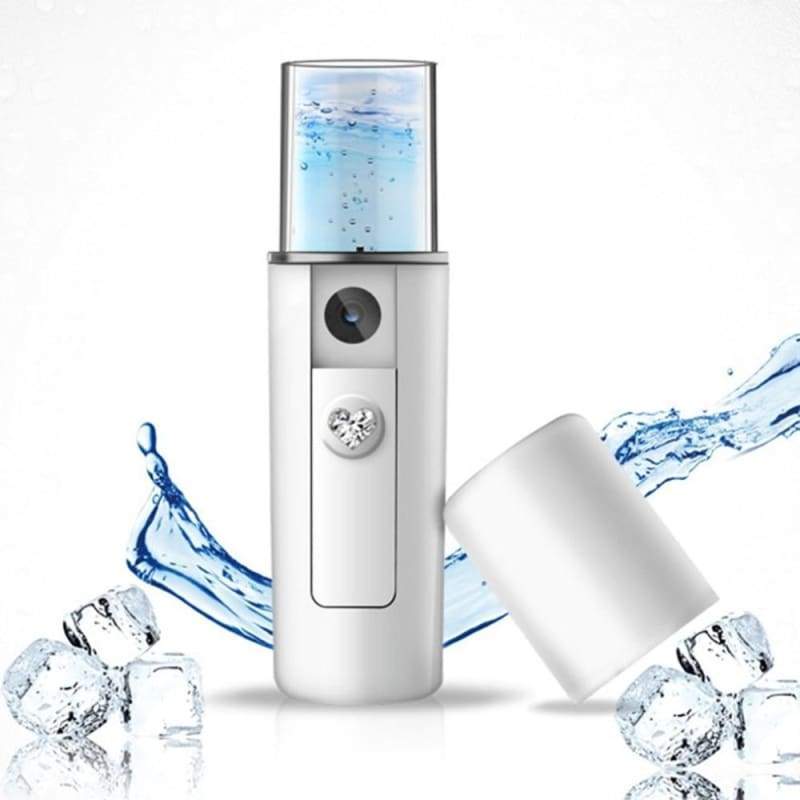
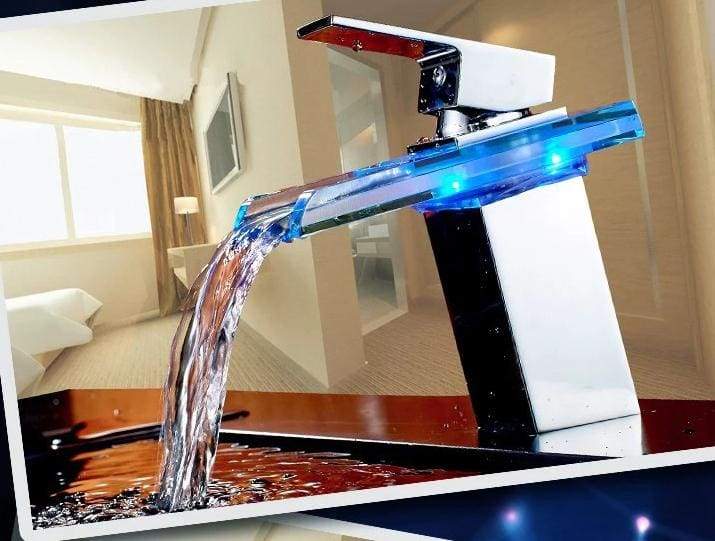
Wildlife Photography Trail Camera
$300.00 Original price was: $300.00.$69.97Current price is: $69.97.
In stock
Fast Trigger Time & Low Glow Infrared Technology,0.2 second trigger time, 120° wide-angle PIR sensor, 82ft detection range, 65ft IR flash range; it does an excellent detection job for you.
Waterproof & Sturdy Design,IP56 waterproof, sturdy housing design, up to 8 months battery life (8 x AA batteries, not included); Ideal for outdoor applications.
Easy to Set up & Use,2.4 inch LCD display, support Micro SD card (not included) up to 32GB; comes with straps and wall mount accessories; easy to set up and use.
User-friendly Camera, The Wildlife camera is very easy to install and operate. You could apply the user-friendly device to indoor/outdoor activities, such as hunting, wildlife monitoring, farm burglar, home security.
Features:
- 12MP images, 1080P FHD videos.
- 90-degree FOV lens, 120-degree detection angle.
- Fast trigger time, easier to capture every amazing moment.
- Multiple working modes to choose: camera, video, camera + video.
- Pcs infra LEDs, provide up to 20m/65ft night vision range.
- Tough and IP65 waterproof body design.
- Low power consumption, extremely long-time standby life, up to 4 – 6 months by 4pcs AA batteries.
- Support cycle recording.
- Date, time, temperature and moon phase stamped at the bottom of pictures and videos.
OUR GUARANTEE
At SK Fashion , we strive to offer top and high-quality products in the world.
We will provide outstanding customer service to assist you as we highly value our customer satisfaction with absolutely Zero Risk.
If you have any questions about your order, please contact us by emailing us at Support@skfashionhub.com
Just click the “Add To Cart” Button Below! There’s very limited stock, and they will go soon!
Note: Due to High Demand Promotional Items May Take Up To 2-4 weeks for delivery.
WE SUPPORT AN AMAZING CAUSE
We’re thrilled to support Nanhi Pari Foundation is a Girl Child Right Organization which works for Education, Health & Nutrition for Girl Child.




1. FREE Shipping Worldwide on special offers.
2. Fast, Sure & Safe delivery.
3. Safe Payment.
4. 30 Day Money Back Guarantee.
5. Real humans on our support help-desk!
6.Tracking number for every order.
7. We use encrypted SSL certificates for 100% security.

Most Important Wildlife Photography Rules
Do you struggle to capture stunning wildlife images? Do you want to take wildlife photographs that pop off the page, but can’t seem to get it right?
This article is about the 10 most important wildlife photography rules. Commit them to memory and watch your photography improve.
1. Fill the Frame With Your Subject to Engage the Viewer
In wildlife photography, it’s often tempting to keep your distance. After all, animals are skittish, and lenses are only so long.
Resist the temptation. Get close, and make sure those wild animals fill the frame.
Why is this important?
Part of what makes wildlife photography so compelling is its ability to transport the viewer into another world: the world of the wild animal.
To thoroughly transport the viewer, you need to offer them intimate detail, and this is done by filling the frame.
If you’re photographing lions, make sure every detail in the fur is captured. Make sure that you can see the catchlights in their eyes.
If you’re photographing a bird, make sure that you can see every feather, and every piece of dirt or dust or sand on their beak.
That’s how you take powerful wildlife images.
2. Learn to Stalk Your Subject to Get Close-Ups
Stalking is one of the most important tools in a wildlife photographer’s toolkit.
What does it mean to stalk? Stalking is the process of getting close to your subject while in the field. When done well, it will enable you to get close enough to follow Rule 1 (fill the frame with your subject).
How do you do this?
One of my favorite stalking methods is called the meander. It’s very simple, just two steps.
Step 1: Get low. Really low. On your hands and knees, or even your stomach.
Step 2: Move toward your subject slowly. Allow yourself to start and stop, to move left and right. Look as if you’re totally nonthreatening and uninterested in your subject.
And that’s it! If you’re patient enough, wildlife will soon view you as a boring feature of the landscape. I’ve used it hundreds of times, and it rarely disappoints.
3. Study Your Subject’s Habits to Capture Unique Moments
Another part of being a successful wildlife photographer?
Having an understanding of your subject.
Imagine that you want to photograph shorebirds. If you know that shorebirds are often found along the local beaches, then you can get to these locations and position yourself so that you can get a great shot.
If you know that shorebirds are active at dawn and dusk, you can make sure to be at the best locations at the proper times.
It’s little things like these that can make a difference between an empty memory card and full one.
Fortunately, learning about your subject isn’t hard. There are tonnes of resources online, all dedicated to wildlife behaviour. Some even cater to photographers.
If you can’t find material on your particular subject, don’t fret. Sometimes learning about your subject is an observational process. That is, you have to make your own field notes. You have to do your own research while out shooting.
If you make a conscious effort to learn about your subject, you’ll have better images in no time.
4. Shoot Only During the Golden Hours
The golden hours are the two hours after sunrise and the two hours before sunset. This is a time when the light is soft, warm, and beautiful.
It’s perfect for wildlife photography. If you shoot during these times, you’ll find that you’ll capture more pleasing images.
For one, your camera is better able to render the balanced, warmer tones of the golden hours. For another, your pictures will have something extra—a sort of elegance—that they wouldn’t possess otherwise.
5. Follow the Rule of Thirds for Balanced Images
The rule of thirds is a compositional principle. Its purpose is to guide artists in arranging their subjects in the most pleasing way possible.
The rule is quite simple. Divide your image into thirds, both vertically and horizontally, creating a three-by-three grid.
Then, place key elements of your composition at the grid points. Additionally, put linear elements of your composition (e.g., horizons) along the grid lines.
For instance, I often place the head of birds on one of the top two intersections. If my image includes an in-focus horizon line, I often place it along the lower grid line.
This ensures that my images are balanced and aesthetically appealing.
You may be tempted to place your subject in the center of the frame. This is a common choice. But such images tend to be very static and awkward.
6. Focus on the Eyes of Your Subject
When you’re using your camera to focus on wildlife, you may struggle to direct its autofocus points.
Which part of an animal’s body must be sharp?
Here’s the answer: the eyes.
If an animal’s eyes are not sharp, then the shot is bad. It’s as simple as that.
The eyes are the first place a viewer looks in an image. This is true for photos of humans, birds, mammals, you name it. So if the eye isn’t sharp, then you’ve already lost your viewer.
Sometimes, you might find yourself unable to focus precisely on the eyes. This might happen if the animal is moving.
That’s okay. Just focus on a part of the animal near to the eyes. You might focus on the face of the animal, or the head.
If you can get these in focus, the eye will generally be in focus, as well.
7. Keep the Background Simple to Not Distract From the Subject
It’s easy to get lost in the thrill of wildlife photography. Especially if you’ve managed to carefully stalk a subject, if you’ve gotten yourself so close that you’re about to take a frame-filling image. You want to take the photo. Your finger is itching to press the shutter button.
This would be a mistake.
Why?
Because you haven’t checked the background.
The thing is, having a strong subject is only part of the work. You also need to have a strong background.
This is something that I constantly emphasize to my students. The background is key. Without a good background, your images will remain lackluster.
Fortunately, finding a good background isn’t hard. A good background is simply a background that doesn’t detract from the subject.
That means no chaos. That means no lines running through your subject’s heads. No trees seemingly sprouting from your subject’s body. No mess of clashing colors.
An ideal background is simple. A pleasing wash of green, created by some nearby plants. Or a nice, neutral white sky.
Backgrounds are often neglected in wildlife photography. But if you pay attention to your backgrounds, you’ll avoid this common mistake—and come away with images that are that much more impressive.
8. Capture Animals in Unique Situations for More Uncommon Photos
Given the number of photographers in the world, if you want to be a great wildlife photographer, your images have to be special. You have to go beyond taking simple snapshots.
How do you do this?
The best way to create powerful wildlife images is to wait for unique moments. These are moments when your intended subject is doing something interesting or unusual.
For birds, this often involves preening, bathing, or wingflaps. If you can catch wildlife in these unique situations, you’re guaranteed a shot that will stand the test of time.
Therefore, don’t just snap away with your camera. Maybe take a few shots to record the beauty of your subject, then start thinking about more impressive images. It may require patience, but it will be worth it.
9. Take Dozens of Images
In wildlife photography, more is almost always better.
This rule may seem to contrast with the previous one, so I would like to clarify. In wildlife photography, more is better when capturing unique moments.
Dozens of images of a lacklustre composition aren’t useful. But dozens of images of a bird bathing? That’s fantastic.
Why is it important to take so many images? Because in wildlife photography, most of your images aren’t going to work. Wildlife rarely poses for you the way you’d like. It turns its head in the wrong direction, or moves when you least expect it.
But if you’re constantly taking images, you can ensure that at least a few of your images turn out.
For those DSLR photographers out there, burst mode is your friend. When I see a bird starting to do something interesting, I hold down that shutter button, taking image after image.
You should do the same. Most of your photographs will turn out bad, but—if you’re lucky—a few will work, and that’s what matters.
10. Practice Ethical Photography to Ensure the Welfare of Your Subject
The final golden rule of wildlife photography is to be ethical.
This may seem like a difficult rule to follow. After all, ethics can be complicated. Debates about ethics abound. How do you know whether you’re acting ethically?
The thing is, I can’t give you hard and fast rules for ethical photography. It’s up to you to develop those on your own. But I’ll give you one main guideline to follow:
The welfare of your subject matters most.
Always be thinking about the harm you could be doing to your subject. For instance, don’t stress the wildlife. If you’ve been stalking your subject, and you notice that they’ve become increasingly agitated, what should you do? Stop. The image isn’t worth it.
The reason why we photograph wildlife is to capture the beauty of the natural world. Yet if we harm our subjects, there won’t be much of a natural world left.
Conclusion
Now that you know these rules, you are a better wildlife photographer.
I’m serious. By following the rules above, you are going to capture stronger images. You’ll get close to your subjects. You’ll work with light and compose carefully. And you’ll take dozens of images, photographing unique moments with powerful backgrounds.
And, most importantly, you’ll be an ethical photographer.
Follow these rules, and you’ll be well on your way to capturing some jaw-dropping wildlife images of your own!
| Weight | 0.4 kg |
|---|



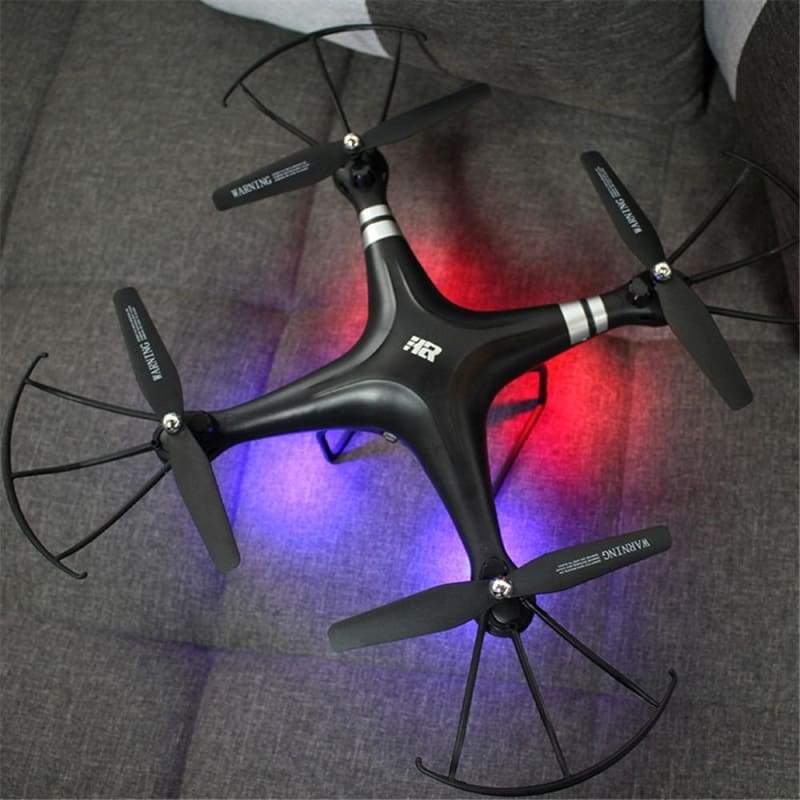
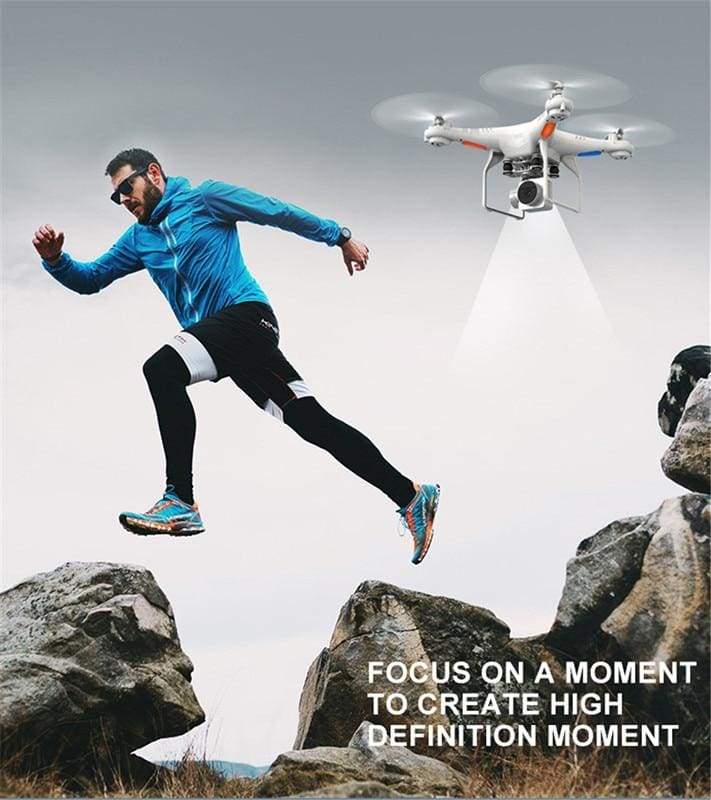







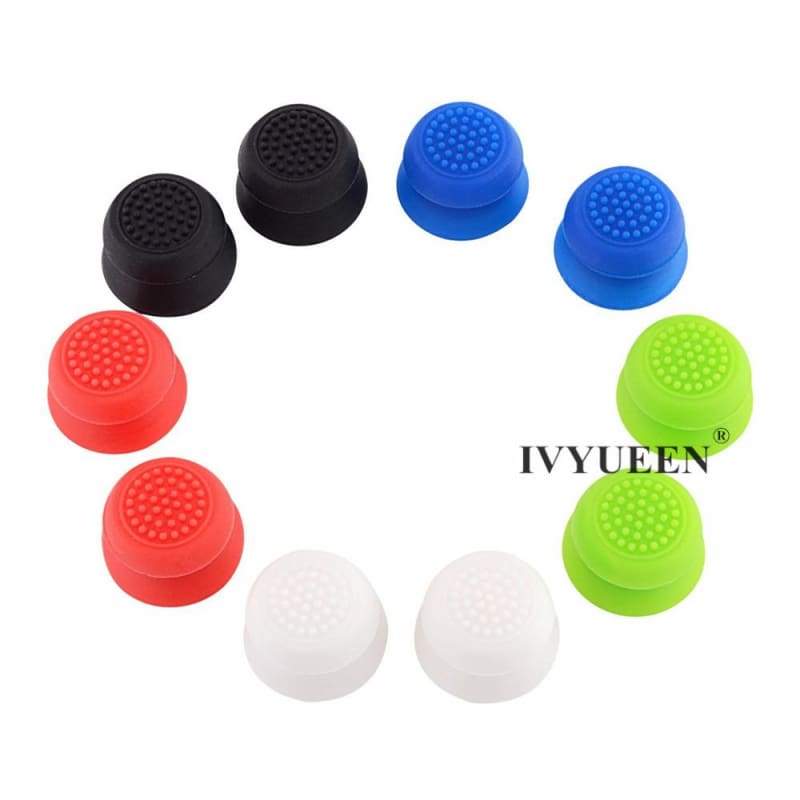
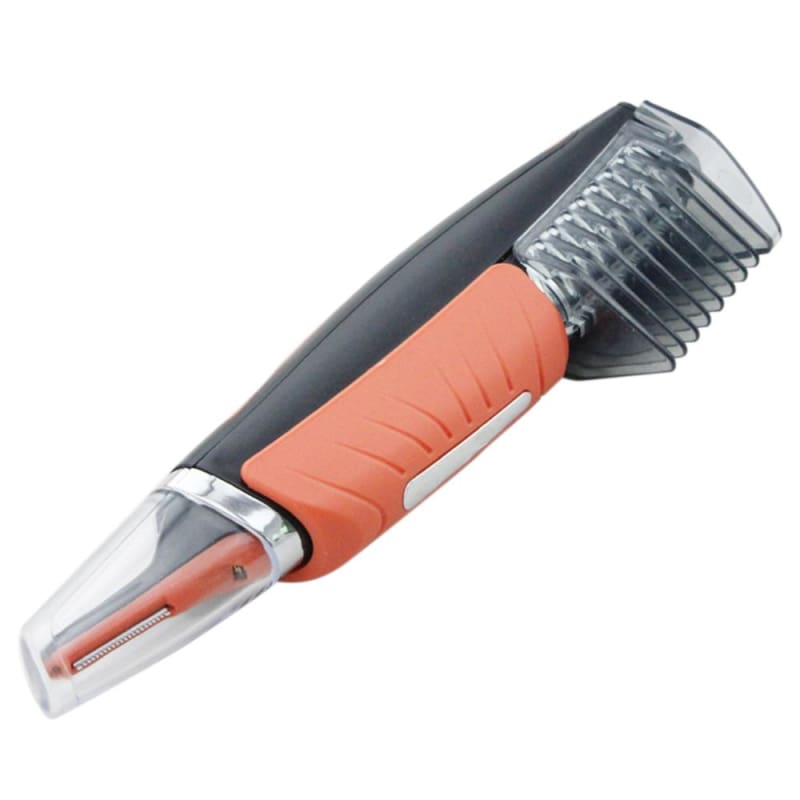
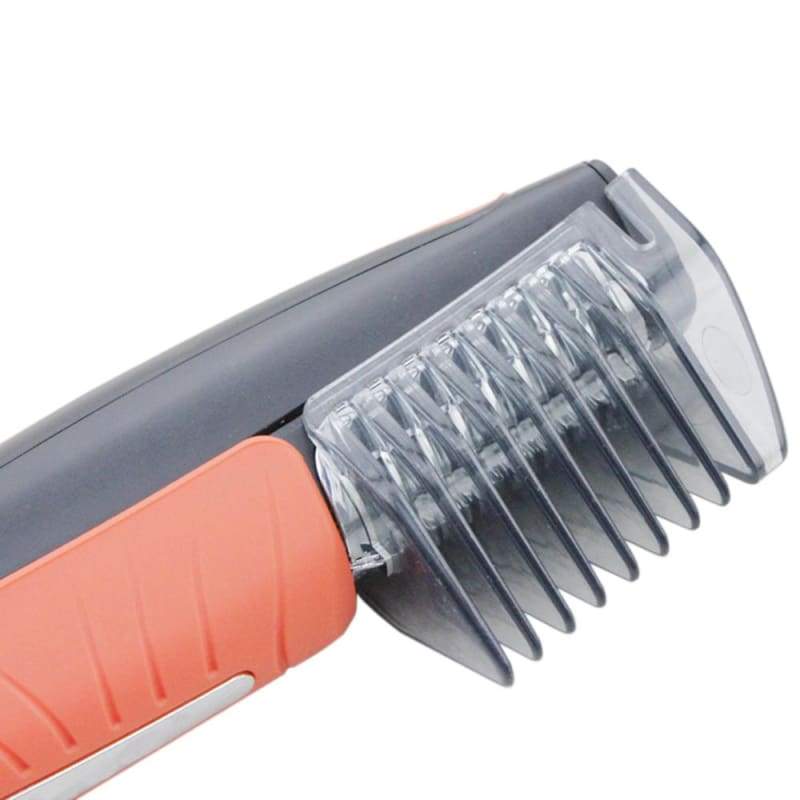


Monserrate Botsford –
I recommend this seller! Everything is cool! Thank you
Aidan Kovacek –
It is as beautiful as the picture. Very happy with this product.
Heber Ullrich –
I love this item! The design is so pretty! Arrived earlier than expected.
Louisa Wilderman –
I think it’s worth with that quality
Cordelia Stanton –
In appearance is not the same as in the picture, there are no inscriptions. Quality seems to be good. A bit expensive
Milford Bartell –
I liked this so much, I purchased it as a gift for my sister.
Rafael O’Connell –
I have not yet tried how it works. thanks to the seller! After use, write off.
Terence Mayer –
I love it, great quality
Isaac Conroy –
It came in less than two weeks, delivery is fast! Item as in description! The seller is sociable and quickly sent the goods! I recommend the price is very good!
Freddy Lubowitz –
I’m happy with the quality
Delbert Brekke –
In general, everything according to the description, although I thought that it did not rather meet my expectation, but for such a price, I do not consider critical
Miller Williamson –
I seriously give this item as a gift probably once a month. Everyone really loves it. You THINK you don’t need this, but once you have it, you will never go back.
Dameon Witting –
In general, everything is fine. Love support team
Damion Walsh –
I order from this seller the second time. Excellent quality, fast delivery. 5 stars!
Percival Bernier –
I really like how to make anything fast and cool, its also very helpful for beginners. Reasonable price
Erwin Johnson –
In general, for their money is excellent. Product meets expectations very well and was delivered very early. Recommend
Freddie Kub –
I received my items in perfect conditions. I highly recommend this seller
Mike Lindgren –
I order from this seller the second time. Excellent quality, fast delivery. I recommend.
Kip Toy –
I’m delighted with the quality. The product was in good condition, well packed
Kay Glover –
I want to complement the review due to awesome service I received. Many thanks to the seller and the store.
Mark –
This product is great!
Sterling Bartell –
Good quality product. Excellent work and thank you, when I can I would like to buy more from this store. Recommend!!!